Yamaha HTR-3071, RX-V383 User Guide
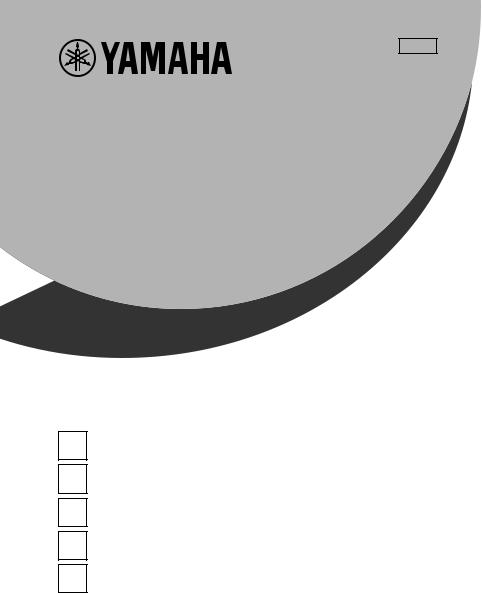
GFS
AV Receiver
Ampli-tuner audio-vidéo
RX-V383/HTR-3071
EN |
Quick Start Guide |
|
Guide de démarrage rapide |
FE |
|
|
Guía de inicio rápida |
ES |
|
|
Guia de Iniciação Rápida |
PT |
|
|
Краткое руководство по началу работы |
RU |
................................................Safety Instructions |
3 |
|
Connections .......................................................... |
5 |
English |
Basic operations ................................................. |
13 |
|
|
|
|
Consignes de sécurité |
17 |
|
|
||
Raccordements................................................... |
19 |
Français |
Fonctionnement de base .................................... |
27 |
|
|
|
|
Instrucciones de seguridad |
31 |
|
|
||
Conexiones ......................................................... |
33 |
Español |
Operaciones básicas .......................................... |
41 |
|
|
|
|
Instruções de segurança |
45 |
|
|
||
Conexões ............................................................ |
47 |
Português |
Operações básicas ............................................. |
55 |
|
|
|
|
Правила техники безопасности |
59 |
|
|
||
Подключения .................................................... |
61 |
Русский |
Основные операции.......................................... |
69 |
|
|
|
|
2En

English
z(power) key |
|
This product is for ordinary homes. Do not use for applications requiring high reliability, such as |
Turns on the power of this unit or sets it to the standby mode. |
|
managing lives, health care or high-value assets. |
|
|
|
|
|
|
CAUTION: READ THIS BEFORE OPERATING YOUR UNIT.
1To assure the finest performance, please read this manual carefully. Keep it in a safe place for future reference.
2Install this sound system in a well ventilated, cool, dry, clean place - away from direct sunlight, heat sources, vibration, dust, moisture, and/or cold. For proper ventilation, allow the following minimum clearances.
Top: 30 cm, Rear: 20 cm, Sides: 20 cm
3Locate this unit away from other electrical appliances, motors, or transformers to avoid humming sounds.
4Do not expose this unit to sudden temperature changes from cold to hot, and do not locate this unit in an environment with high humidity (i.e. a room with a humidifier) to prevent condensation inside this unit, which may cause an electrical shock, fire, damage to this unit, and/or personal injury.
5Avoid installing this unit where foreign object may fall onto this unit and/or this unit may be exposed to liquid dripping or splashing. On the top of this unit, do not place:
–Other components, as they may cause damage and/or discoloration on the surface of this unit.
–Burning objects (i.e. candles), as they may cause fire, damage to this unit, and/or personal injury.
–Containers with liquid in them, as they may fall and liquid may cause electrical shock to the user and/or damage to this unit.
6Do not cover this unit with a newspaper, tablecloth, curtain, etc. in order not to obstruct heat radiation. If the temperature inside this unit rises, it may cause fire, damage to this unit, and/or personal injury.
7Do not plug in this unit to a wall outlet until all connections are complete.
8Do not operate this unit upside-down. It may overheat, possibly causing damage.
9Do not use force on switches, knobs and/or cords.
10When disconnecting the power cable from the wall outlet, grasp the plug; do not pull the cable.
11Do not clean this unit with chemical solvents; this might damage the finish. Use a clean, dry cloth.
12Only voltage specified on this unit must be used. Using this unit with a higher voltage than specified is dangerous and may cause fire, damage to this unit, and/or personal injury. Yamaha will not be held responsible for any damage resulting from use of this unit with a voltage other than specified.
13To prevent damage by lightning, keep the power cable and outdoor antennas disconnected from a wall outlet or this unit during a lightning storm.
14Do not attempt to modify or fix this unit. Contact qualified Yamaha service personnel when any service is needed. The cabinet should never be opened for any reasons.
15When not planning to use this unit for long periods of time (i.e. vacation), disconnect the AC power plug from the wall outlet.
16Be sure to refer to the “Troubleshooting” section of the Owner’s Manual on the CD-ROM for common operating errors before concluding that this unit is faulty.
17Before moving this unit, press zto set it to standby mode and disconnect the AC power plug from the wall outlet.
18VOLTAGE SELECTOR (Taiwan, Brazil and General models)
The VOLTAGE SELECTOR on the rear panel of this unit must be set for your local main voltage BEFORE plugging into the AC wall outlet. Voltages are:
......................................................................................................... AC 110-120/220-240 V, 50/60 Hz
19Condensation will form when the surrounding temperature changes suddenly. Disconnect the power cable from the outlet, then leave this unit alone.
20When using this unit for a long time, this unit may become warm. Turn the power off, then leave this unit alone for cooling.
21Install this unit near the AC outlet and where the AC power plug can be reached easily.
22Excessive sound pressure from earphones and headphones can cause hearing loss.
This unit is not disconnected from the AC power source as long as it is connected to the wall outlet, even if this unit itself is turned off by z. This state is called the standby mode. In this state, this unit is designed to consume a very small quantity of power.
WARNING
TO REDUCE THE RISK OF FIRE OR ELECTRIC SHOCK, DO NOT EXPOSE THIS UNIT TO RAIN OR MOISTURE.
En 3
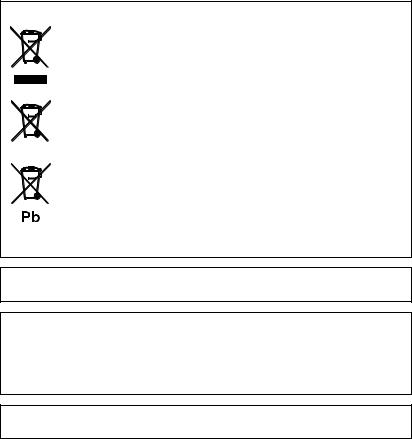
■ Notes on remote controls and batteries
•Do not spill water or other liquids on the remote control.
•Do not drop the remote control.
•Do not leave or store the remote control in the following conditions:
–places of high humidity, such as near a bath
–places of high temperatures, such as near a heater or stove
–places of extremely low temperatures
–dusty places
•Insert the battery according to the polarity markings (+ and -).
•Change all batteries if you notice the following conditions:
–the operation range of the remote control narrows
–the transmit indicator does not flash or is dim
•If the batteries run out, immediately remove them from the remote control to prevent an explosion or acid leak.
•If you find leaking batteries, discard the batteries immediately, taking care not to touch the leaked material. If the leaked material comes into contact with your skin or gets into your eyes or mouth, rinse it away immediately and consult a doctor. Clean the battery compartment thoroughly before installing new batteries.
•Do not use old batteries together with new ones. This may shorten the life of the new batteries or cause old batteries to leak.
•Do not use different types of batteries (such as alkaline and manganese batteries) together. Specification of batteries may be different even though they look the same.
•Before inserting new batteries, wipe the compartment clean.
•If the remote control is without batteries for more than 2 minutes, or if exhausted batteries remain in the remote control, the contents of the memory may be cleared. In such a case, install new batteries and set the remote control code.
•Dispose of batteries according to your regional regulations.
•Keep batteries away from children. If a battery is accidentally swallowed, contact your doctor immediately.
•When not planning to use the remote control for long periods of time, remove the batteries from the remote control.
•Do not charge or disassemble the supplied batteries.
•The batteries shall not be exposed to excessive heat such as sunshine, fire or like.
Information for Users on Collection and Disposal of Old Equipment and Used Batteries
These symbols on the products, packaging, and/or accompanying documents mean that used electrical and electronic products and batteries should not be mixed with general household
waste.
For proper treatment, recovery and recycling of old products and used batteries, please take them to applicable collection points, in accordance with your national legislation and the Directives 2002/96/EC and 2006/66/EC.
By disposing of these products and batteries correctly, you will help to save valuable resources and prevent any potential negative effects on human health and the environment which could otherwise arise from inappropriate waste handling.
For more information about collection and recycling of old products and batteries, please contact your local municipality, your waste disposal service or the point of sale where you purchased the items.
[Information on Disposal in other Countries outside the European Union]
These symbols are only valid in the European Union. If you wish to discard these items, please contact your local authorities or dealer and ask for the correct method of disposal.
Note for the battery symbol (bottom two symbol examples):
This symbol might be used in combination with a chemical symbol. In this case it complies with the requirement set by the Directive for the chemical involved.
For more detailed information, refer to the Owner’s Manual on the CD-ROM. Caution: Do not attempt to play this CD-ROM in an audio player.
To view the Owner’s Manual, click on “English” in the screen displayed automatically when you insert the CD-ROM into your PC, or click on the model name if the screen to select models is displayed, and then click on “English” in the next screen. Then, follow the onscreen instructions. If the screen is not displayed automatically, open the “index.html” in the CD-ROM.
The Owner’s Manual contained in the CD-ROM can be downloaded from the following website: URL : http://download.yamaha.com/
Do not use this unit within 22 cm (9 inches) of persons with a heart pacemaker implant or defibrillator implant.
4En
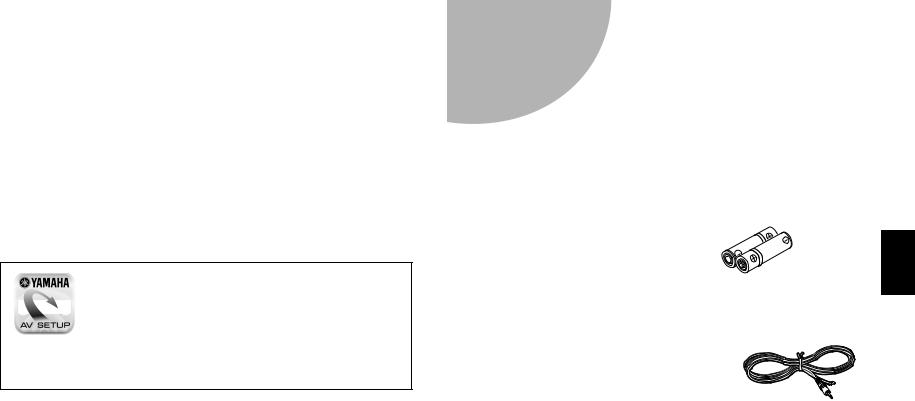
This document explains basic speaker system setup and unit configuration, followed by step-by-step instructions. Basic operations, such as playing Blu-ray Discs, DVDs, and radio content, are also explained.
The unit is equipped with a number of other functions not described in this booklet. For more information about this product, refer to the Owner’s Manual included on the supplied CD-ROM. The latest Owner’s Manual can be downloaded from the following website. http://download.yamaha.com/
[For U.S. customers only]
Visit the following website for additional information, FAQ’s, downloads such as “Owner’s Manual” and product updates.
http://usa.yamaha.com/support/
AV SETUP GUIDE
AV SETUP GUIDE is an app that guides you through the process of connecting a TV or playback device, such as a BD/DVD or CD player, and speakers to the AV receiver. Search “AV SETUP GUIDE” on the App Store or Google Play for details.
1Preparation
Confirming package contents
Batteries (AAA, R03, UM-4)
(x2)
Remote control
AM antenna |
FM antenna |
YPAO microphone |
One of the above is supplied depending on the region of purchase.
CD-ROM (Owner’s Manual)
Quick Start Guide (this booklet)
Preparing cables
The following cables (not supplied) are required to build the system described in this document.
•Speaker cables (depending on the number of speakers)
•Audio pin cable (x1)
•HDMI cables (x3)
En 5
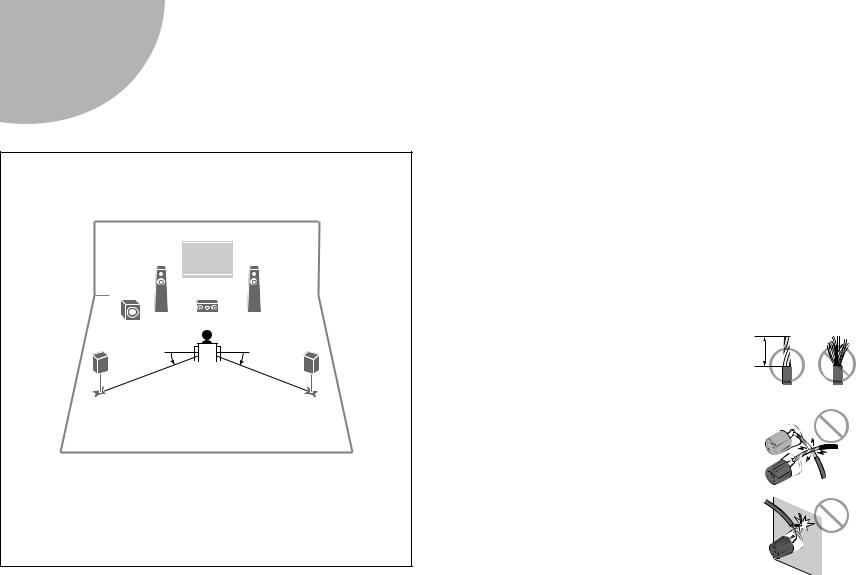
2Connecting speakers/subwoofer
Positioning speakers
Use the diagram as a reference for positioning speakers.
1
 2
2
9 3
3
4 5
10° to 30° |
|
|
|
|
|
10° to 30° |
|
|
|
|
|
1Front speaker (L)
2Front speaker (R)
3Center speaker
4Surround speaker (L)
5Surround speaker (R)
9Subwoofer
When connecting 6-ohm speakers (U.S.A. and Canada models only)
Set the unit’s speaker impedance to “6 Ω MIN”. For details, see “Setting the speaker impedance” in the Owner’s Manual.
Precautions for connecting speaker cables
•Be sure that the unit and subwoofer are turned off.
•Prepare speaker cables in a place away from the unit, to avoid accidentally dropping wire strands into the unit's interior which could result in a short circuit or malfunction of the unit.
•Improper connection of speaker cables could cause a short circuit resulting in damage to, or malfunctioning of, the unit or speakers.
– Carefully remove approximately 10 mm
(3/8") of insulation from the speakerconnection ends of the cables, and twist the bare wires of each speaker cable together firmly.
–Do not allow the bare wires of separate speaker cables to come into contact with one another.
–Do not allow speaker cable bare wires to come into contact with metal parts on the unit (rear panel and
screws).
If “Check SP Wires” is shown on the front display when the unit is turned on, turn off the unit and be sure that speaker cables have not caused a short circuit.
6En

1 |
2 |
1 |
2 |
|
10 mm |
|
10 mm |
|
(3/8") |
|
(3/8") |
3 |
4 |
3 |
4 |
Audio pin cable
9
Subwoofer
Use a subwoofer equipped with built-in amplifier.
5 |
4 |
3 |
Surround speaker (R) |
Surround speaker (L) |
Center speaker |
2 1
Front speaker (R) |
Front speaker (L) |
En 7

3Connecting external devices
HDMI OUT
ARC
HDCP2.2
|
|
HDMI (HDCP2.2) |
|
1 |
2 |
3 |
4 |
(BD/DVD) |
|
|
|
HDMI |
HDMI |
HDMI |
HDMI |
|
HDMI |
HDMI |
HDMI input |
|
HDMI |
|
HDMI output |
HDMI output |
HDMI |
HDMI |
|
|
|
|
TV |
BD/DVD player |
Satellite/cable set top box |
|
8En
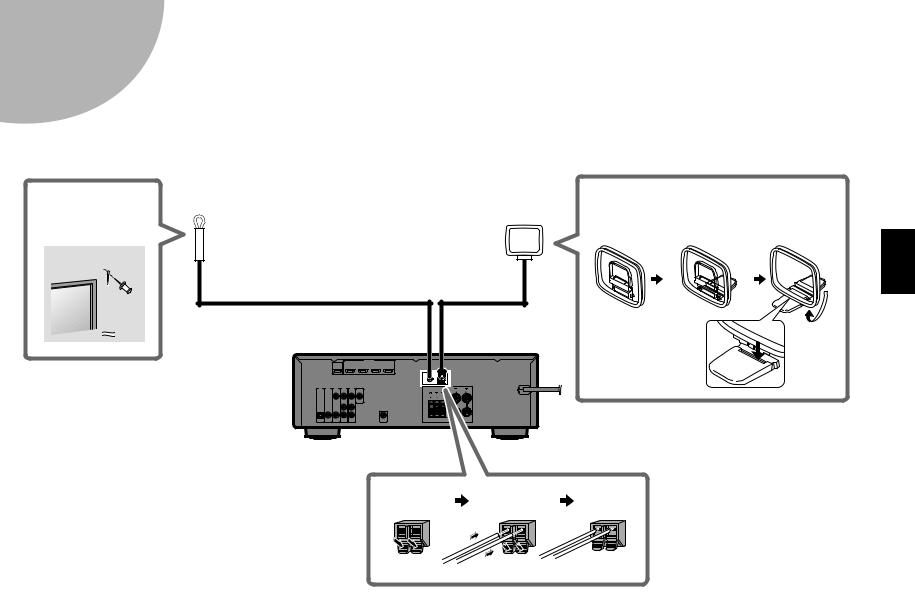
4Connecting the FM/AM antennas
Fix the end of the FM antenna to a wall.
FM antenna (supplied) |
|
Assembling the AM antenna |
|
|
Place the AM |
|
|
antenna on a flat |
|
AM antenna (supplied) |
surface. |
|
|
Hold down |
Insert |
Release |
En 9
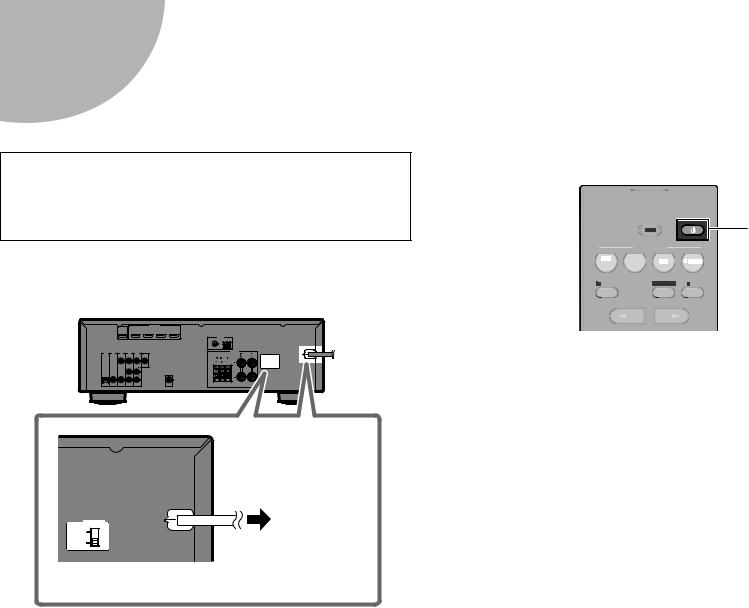
5Connecting the power cable to an AC wall outlet, and turning on the unit
Before connecting the power cable (Taiwan, Brazil and General models only)
Set the switch position of VOLTAGE SELECTOR according to your local voltage.
Voltages are AC 110–120/220–240 V, 50/60 Hz.
2 Press z(receiver power) to turn on the unit.
|
|
z |
SLEEP |
SCENE
1 Plug the power cable into an AC wall outlet.
|
|
|
BD |
|
|
|
|
TV |
|
|
|
CD |
|
|
|
|
|
|
DVD |
|
|
|
|
|
|
|
|
RADIO |
|||||
|
|
|
|
|
|
|
|
|
|
|
|
BASS |
|
|||
|
|
|
STRAIGHT |
|
|
|
|
|
|
|
|
|
|
|||
|
|
|
|
|
|
|
ENHANCER |
|
|
|||||||
PROGRAM
3Turn on the TV and switch the TV input to display video from the unit (HDMI OUT jack).
To an AC wall
VOLTAGE outlet SELECTOR
110V-
120V
220V-
240V
VOLTAGE SELECTOR
(Taiwan, Brazil and General models only)
10 En
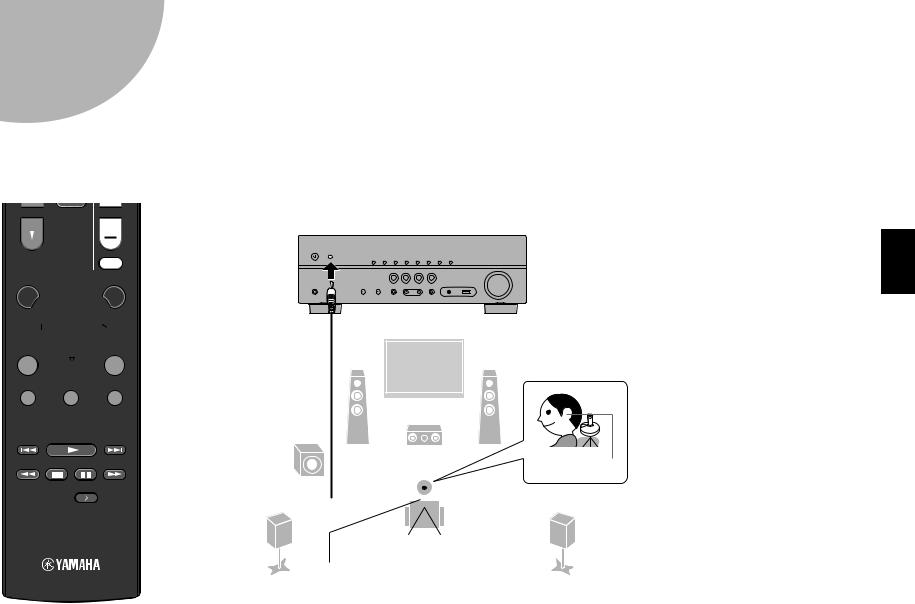
6Optimizing the speaker settings automatically (YPAO)
The Yamaha Parametric room Acoustic Optimizer (YPAO) function detects speaker connections, measures the distances from them to your listening position(s), and then automatically optimizes the speaker settings, such as volume balance and acoustic parameters, to suit your room.
 ENTER
ENTER
Cursor keys
1 2
3
9
Ear height
4 

 5
5
Note the following regarding YPAO measurement
•Test tones are output at high volume and may surprise or frighten small children.
•Test tone volume cannot be adjusted.
•Keep the room as quiet as possible.
•Stay in a corner of the room behind the listening position so that you do not become an obstacle between speakers and the YPAO microphone.
•Do not connect headphones.
Listening position
YPAO microphone
En 11
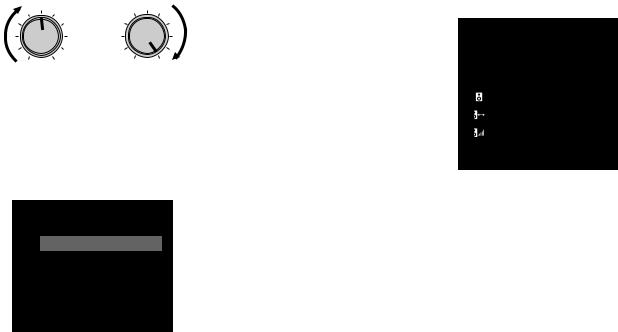
1 Turn on the subwoofer and set the volume to half.
If the crossover frequency is adjustable, set it to maximum.
VOLUME |
CROSSOVER/ |
|
HIGH CUT |
||
|
MIN MAX |
MIN MAX |
2Place the YPAO microphone at your listening position and connect it to the YPAO MIC jack on
the front panel.
The screen below appears on the TV.
 Auto Setup
Auto Setup
 Start
Start
 Exit
Exit
Note
Place the YPAO microphone at your listening position (same height as your ears). We recommend the use of a tripod as a microphone stand. You can use the tripod screws to stabilize the microphone.
3 Press ENTER.
The measurement will start in 10 seconds. It takes about 3 minutes to measure.
The screen below appears on the TV when the measurement finishes.
 Auto Setup
Auto Setup
Measurement Finished
Result
3/2/0.1ch
3.0/10.5m
-3.0/+10.0dB
OK : ENTER
Note
If an error message (such as E-1) or warning message (such as W-2) appears, see “Error messages” or “Warning messages” under “Optimizing the speaker settings automatically (YPAO)” in the Owner’s Manual.
4Confirm the results displayed on the screen and press ENTER.
5Use the cursor keys (e/r) to select “SAVE” (Save) and press ENTER.
6 Disconnect the YPAO microphone from the unit.
This completes optimization of the speaker settings.
12 En

Basic operations
This section describes basic operations such as playing Blu-ray Discs and DVDs, and tuning into radio stations. Most operations can be performed using the remote control.
Operating the remote control
Turn on/off (standby) the unit
The unit is equipped programs and surround
enjoy playback sources in your favorite sound mode.
STRAIGHT: Input sources will be played without any sound field effects.
ENHANCER: Compressed music stored on a Bluetooth device or USB storage device will be played with additional depth and breadth.
BASS: Extra bass allows you to enjoy enhanced bass sounds.
PROGRAM (e/r): Sound programs suitable for movies, music and stereo playback can be selected.
Select an input source
Unit input sources and settings that have been assigned to SCENE keys can be selected with just one touch (SCENE function).
The unit turns on automatically when it is in standby mode. By default, the following settings assigned to each SCENE key.
|
|
|
|
|
|
|
SCENE key |
BD |
TV |
CD |
RADIO |
|
SLEEP |
|
|||||||||||
|
|
|||||||||||
|
|
|
|
|
|
|
|
DVD |
|
|
|
|
|
|
|
|
|
|
|
|
|
|
|
|
|
|
|
|
|
|
|
|
Input |
HDMI1 |
AUDIO1 |
AUDIO2 |
TUNER |
|
|
|
|
|
|
|
|
|
|
|
|
|
|
|
|
|
|
|
|
|
Sound program |
MOVIE |
STRAIGHT |
STRAIGHT |
STEREO |
|
|
|
|
|
|
|
|
(5ch |
|
||||
|
|
|
|
|
|
|
(Sci-Fi) |
|
||||
|
|
|
|
|
|
|
|
|
|
Stereo) |
|
|
|
|
|
|
|
|
|
|
|
|
|
|
|
|
|
|
|
|
|
|
|
|
|
|
|
|
|
|
|
|
|
|
|
Compressed |
Off |
On |
Off |
On |
|
|
|
|
|
|
|
|
Music Enhancer |
|
||||
|
|
|
|
|
|
|
|
|
|
|
|
|
|
|
|
|
|
|
|
|
|
|
|
|
|
|
|
|
|
|
|
|
SCENE link |
On |
On |
Off |
Off |
|
|
|
|
|
|
|
|
playback |
|
||||
|
|
|
|
|
|
|
|
|
|
|
|
|
|
|
|
|
|
|
|
|
|
|
|
|
|
|
|
|
|
|
|
|
|
|
|
|
|
|
|
|
|
|
|
|
|
|
|
|
|
|
|
|
|
|
|
|
|
|
|
|
|
|
|
|
|
|
|
|
|
|
|
|
|
|
|
|
|
|
|
|
|
|
|
|
|
|
|
|
|
|
Adjust the volume level
|
|
|
|
|
|
|
|
|
|
|
|
|
|
|
|
|
|
|
|
|
|
|
|
|
|
|
|
|
|
|
|
|
|
|
|
|
|
|
|
|
|
|
|
|
|
|
|
|
|
|
|
|
|
|
|
|
|
|
|
|
|
|
|
|
|
|
|
|
|
|
|
|
|
|
SETUP |
|
OPTION |
|
|
|
|
|
Mute the audio output |
|
|
|
|
|
|
|
|
|
|
|
|
|
|
|
|
|
|
|
|
|
|
|
|
|
|
|
|
En 13
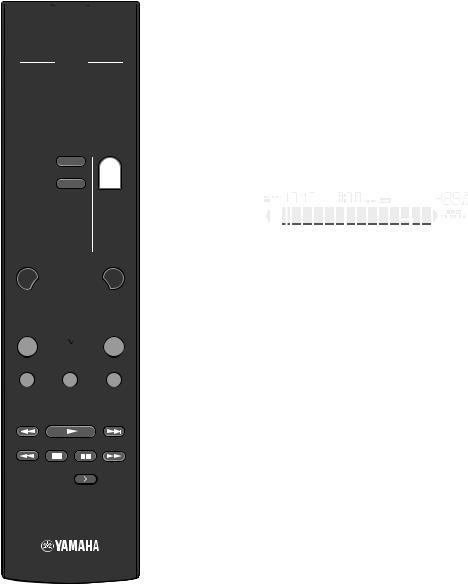


 STRAIGHT
STRAIGHT
 VOLUME (
VOLUME ( / )
/ )
 INPUT (q/w)
INPUT (q/w)
Playing a BD/DVD
We recommend playing back multichannel audio (5.1-channel or more) to feel surround sound produced by the unit.
1 Turn on the BD/DVD player.
2Press INPUT (q/w) repeatedly to select “HDMI 1”.
The name of the connected device such as “BD player” may be displayed.
CHARGE |
|
|
|
ENHANCER STEREO TUNED SLEEP MUTE |
||
OUT |
|
|
|
|
|
VOL. |
ECO |
|
BD Player |
|
ADAPTIVE DRCVIRTUAL |
||
|
|
|
||||
|
|
|
|
|||
|
|
|
|
|||
|
|
|
|
|
||
Input source |
Device name |
|||||
3Start playback on the BD/DVD player.
4Press STRAIGHT to select “STRAIGHT”.
Note
When “STRAIGHT” (straight decode) is enabled, each speaker produces each channel audio signal directly (without sound field processing).
5Press VOLUME to adjust the volume.
Note
When sound is not heard, or no sound is output from a specific speaker, see “Troubleshooting” in the Owner’s Manual.
14 En

|
|
|
|
|
|
|
|
|
|
|
|
|
|
|
|
|
|
|
|
|
Listening to FM/AM radio |
|
|
|
|
|
|
|
|
Setting the frequency steps (Asia, Taiwan, Brazil |
|||||||||||||||||
|
|
|
|
|
|
|
|
|
|
|
1 |
|
|||||||||||
|
|
|
|
|
|
|
|
|
|
|
Press FM/AM to select a band. |
and General models only) |
|||||||||||
|
|
|
|
|
|
|
|
|
|
|
|
|
|
|
|
|
|
|
|
|
|
“TUNER” is selected as the input source and then |
At the factory, the frequency step setting is set to 50 kHz |
|
|
|
|
|
|
|
|
|
|
|
|
|
|
|
|
|
|
|
|
|
|
for FM and 9 kHz for AM. |
|
|
|
|
|
|
|
|
|
|
|
|
|
|
|
|
|
|
|
|
|
|
|
the frequency currently selected is displayed. |
|
|
|
|
|
|
|
|
|
|
|
|
|
|
|
|
|
|
|
|
2 |
|
Depending on your country or region, set the frequency |
||
|
|
|
|
|
|
|
|
|
|
|
|
|
|
|
|
|
|
|
Press TUNING repeatedly to set a |
steps to 100 kHz for FM and 10 kHz for AM. |
|||
|
|
|
|
|
|
|
|
|
|
|
|
|
|
|
|
|
|
|
|||||
|
|
|
|
|
|
|
|
|
|
|
|
|
|
|
|
|
|
|
1 Set the unit to standby mode. |
||||
|
|
|
|
|
|
|
|
|
|
|
|
|
|
|
|
|
|
|
|
|
|
frequency. |
2 Hold down STRAIGHT on the front panel and press |
|
|
|
|
|
|
|
|
|
|
|
|
|
|
|
|
|
|
|
|
|
|
||
|
|
|
|
|
|
|
|
|
|
|
|
|
|
|
|
|
|
|
|
|
|
Hold down the key for about a second to search |
z(power). |
|
|
|
|
|
|
|
|
|
|
|
|
|
|
|
|
|
|
|
|
|
|
3 Press PROGRAM on the front panel repeatedly to |
|
|
|
|
|
|
|
|
|
|
|
|
|
|
|
|
|
|
|
|
|
|
FM/AM |
stations automatically. |
|
|
|
|
|
|
|
|
|
|
|
|
|
|
|
|
|
|
|
|
|
|
select “TU”. |
||
|
|
|
|
|
|
|
|
|
|
|
|
|
|
|
|
|
|
|
|
|
|
|
|
LINK MASTER |
STEREO TUNED |
ZONE |
|
LINK MASTER |
STEREO TUNED ZONE |
|
|
||
|
|
2 A 3 B |
|
|
|
||||
|
|
SLEEP PARTY |
|
|
|
|
SLEEP PARTY 2 A 3 B |
|
|
OUT |
2 |
Hi-Res ENHANCER YPAO VOL. A-DRC |
|
OUT |
2 |
Hi-Res ENHANCER YPAO VOL. A-DRC |
|
|
|
ECO |
|
|
VOL. MUTE VIRTUAL |
ECO |
|
|
VOL. MUTE VIRTUAL |
||
|
|
|
FPL |
FPR |
|
|
|
FPL |
FPR |
|
|
|
SL SW SR |
|
|
|
SL SW SR |
||
|
|
FM 98.50MHz SBL SB SBR |
|
TU••••FM50/AM9 |
|||||
|
|
|
SBL SB SBR |
||||||
|
|
|
|
|
|
|
|
|
|
|
|
|
|
|
|
|
|
|
“TUNED” lights up when the unit is receiving an FM/ |
4 |
Press STRAIGHT on the front panel to select |
|
|
|
|
|
|
|
|
|
|
|
|
|
|
|
|
|
|
|
AM radio station signal. |
|
“FM100/AM10”. |
|
|
|
|
|
|
|
|
|
|
|
|
|
|
|
|
|
|
|
|
||
|
|
|
|
|
|
|
|
|
|
|
|
|
|
|
|
|
|
|
|
||
|
|
|
|
|
|
|
|
|
|
|
|
|
|
|
|
|
|
|
“STEREO” lights up when the unit is receiving a |
5 |
Press z(power) to set the unit to standby mode and |
|
|
|
|
|
|
|
|
|
|
|
|
|
|
|
|
|
|
|
|||
|
|
|
|
|
|
|
|
|
|
|
|
|
|
|
|
|
|
|
stereo FM radio signal. |
|
turn it on again. |
|
|
|
|
|
|
|
|
|
|
|
|
|
|
|
|
|
|
|
|
||
|
|
|
|
|
|
|
|
|
|
|
|
|
|
|
|
|
|
|
|
|
|
|
|
|
|
|
|
|
|
|
|
|
|
|
|
|
|
|
|
|
|
|
|
|
|
|
|
|
|
|
|
|
|
|
|
|
|
|
|
|
|
|
|
|
|
|
|
|
|
|
|
|
|
|
|
|
|
|
|
|
|
|
|
|
|
|
|
|
|
|
|
|
|
|
|
|
|
|
|
|
|
|
|
|
|
|
|
|
|
|
|
|
|
|
|
|
|
|
|
|
|
|
|
|
|
|
|
|
|
|
|
|
|
|
|
|
|
|
|
|
|
|
|
|
|
|
|
|
|
|
|
|
|
|
|
|
|
|
|
|
|
|
|
|
|
|
|
|
|
|
|
|
|
|
|
 TUNING
TUNING
En 15
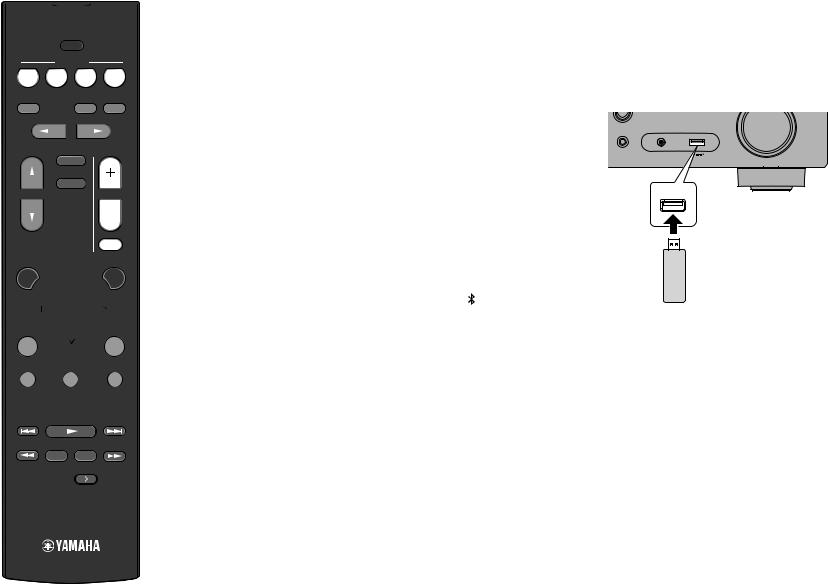
|
|
|
|
|
|
|
|
|
|
|
|
|
|
|
|
|
|
|
|
Playing music stored on a |
|
|
|
|
|
|
|
|
|
|
|
|
|
|
|
|
|
|
|
|
Bluetooth® device |
|
|
|
|
|
|
|
|
|
|
|
|
|
|
|
|
|
|
|
|
1 Press BLUETOOTH to select |
|
|
|
|
|
|
|
|
|
|
|
|
|
|
|
|
|
|
|
|
|
|
|
|
|
|
|
|
|
|
|
|
|
|
|
|
|
|
|
|
|
“Bluetooth” as the input source. |
|
|
|
|
|
|
|
|
|
|
|
|
|
|
|
|
|
|
|
|
2 Hold down MEMORY for more than |
|
|
|
|
|
|
|
|
|
|
|
|
|
|
|
|
|
|
|
|
|
|
|
|
|
|
|
|
|
|
|
|
|
|
|
|
|
|
|
|
|
|
|
|
|
|
|
|
|
|
|
|
|
|
|
|
|
|
|
|
|
|
3 seconds. |
|
|
|
|
|
|
|
|
|
|
|
|
|
|
|
|
|
|
|
|
“Searching…” appears in the front display. |
|
|
|
|
|
|
|
|
|
|
|
|
|
|
|
|
|
|
|
|
|
|
|
|
|
|
|
|
|
|
|
|
|
|
|
|
|
|
|
|
USB |
3 Turn on the BLUETOOTH function |
|
|
|
|
|
|
|
|
|
|
|
|
|
|
|
|
|
|
|
BLUETOOTH |
on your device, and select the |
|
|
|
|
|
|
|
|
|
|
|
|
|
|
|
|
|
|
|
||
|
|
|
|
|
|
|
|
|
|
|
|
|
|
|
|
|
|
|
|
model name of the unit from the |
|
|
|
|
|
|
|
|
|
|
|
|
|
|
|
|
|
|
|
|
|
|
|
|
|
|
|
|
|
|
|
|
|
|
|
|
|
|
|
|
|
BLUETOOTH device list on your |
|
|
|
|
|
|
|
|
|
|
|
|
|
|
|
|
|
|
|
|
|
|
|
|
|
|
|
|
|
|
|
|
|
|
|
|
|
|
|
|
|
device. |
|
|
|
|
|
|
|
|
|
|
|
|
|
|
|
|
|
|
|
|
|
|
|
|
|
|
|
|
|
|
|
|
|
|
|
|
|
|
|
|
|
If the pass key is required, enter the number “0000”. |
|
|
|
|
|
|
|
|
|
|
|
|
|
|
|
|
|
|
|
|
|
|
|
|
|
|
|
|
|
|
|
|
|
|
|
|
|
|
|
|
|
|
|
|
|
|
|
|
|
|
|
|
|
|
|
|
|
|
|
|
|
ENTER |
When the connection is established, the |
|
|
|
|
|
|
|
|
|
|
|
|
|
|
|
|
|
|
|
Cursor |
indicator will glow in the front display. |
|
|
|
|
|
|
|
|
|
|
|
|
|
|
|
|
|
|
|
keys |
4 Select a song and start playback on |
|
|
|
|
|
|
|
|
|
|
|
|
|
|
|
|
|
|
|
|
|
|
|
|
|
|
|
|
|
|
|
|
|
|
|
|
|
|
|
|
|
the Bluetooth device. |
|
|
|
|
|
|
|
|
|
|
|
|
|
|
|
|
|
|
|
|
|
|
|
|
|
|
|
|
|
|
|
|
|
|
|
|
|
|
|
|
|
Note |
|
|
|
|
|
|
|
|
|
|
|
|
|
|
|
|
|
|
|
|
Audio playing on the unit can be transmitted to Bluetooth |
|
|
|
|
|
|
|
|
|
|
|
|
|
|
|
|
|
|
|
|
|
|
|
|
|
|
|
|
|
|
|
|
|
|
|
|
|
|
|
|
|
wireless speakers or headphones (except when Bluetooth is |
|
|
|
|
|
|
|
|
|
|
|
|
|
|
|
|
|
|
|
MEMORY |
selected as the unit’s input source). See “Enjoying audio using |
|
|
|
|
|
|
|
|
|
|
|
|
|
|
|
|
|
|
|
|
Bluetooth speakers/headphones” in the Owner’s Manual for |
|
|
|
|
|
|
|
|
|
|
|
|
|
|
|
|
|
|
|
|
|
|
|
|
|
|
|
|
|
|
|
|
|
|
|
|
|
|
|
|
|
more information. |
|
|
|
|
|
|
|
|
|
|
|
|
|
|
|
|
|
|
|
|
|
|
|
|
|
|
|
|
|
|
|
|
|
|
|
|
|
|
|
|
|
|
|
|
|
|
|
|
|
|
|
|
|
|
|
|
|
|
|
|
|
|
|
|
|
|
|
|
|
|
|
|
|
|
|
|
|
|
|
|
|
|
|
|
Playing music stored on a USB flash drive
1Connect the USB flash drive to the USB jack.
RADIO
AUX |
USB |
STRAIGHT
USB flash drive
Note
Connect the USB flash drive directly to the USB jack. Do not use an extension cable.
2Press USB to select “USB” as the input source.
The browse screen is displayed on the TV.
3Use the cursor keys to select an item and press ENTER.
When a song is selected, playback starts and the playback screen is displayed.
16 En

Français
Touche z(alimentation)
Mettez l’appareil sous tension ou réglez-le en mode de mise en veille.
Ce produit est conçu pour un usage courant dans les résidences standard. Ne l'utilisez pas pour des applications nécessitant une haute fiabilité, telles que la gestion des gestes essentiels à la vie, des soins de santé ou des biens de grande valeur.
ATTENTION : VEUILLEZ LIRE CE QUI SUIT AVANT D’UTILISER L’APPAREIL.
1Pour utiliser l’appareil au mieux de ses possibilités, lisez attentivement ce mode d’emploi. Conservez-le soigneusement pour référence.
2Installez cet ensemble audio dans un endroit bien aéré, frais, sec et propre - veillez à ce qu’il soit à l’abri de la lumière directe du soleil, des sources de chaleur, des vibrations, des poussières, de l’humidité et/ou du froid. Pour une ventilation correcte, ménagez l’espace minimum suivant. Au-dessus : 30 cm, À l’arrière : 20 cm, Sur les côtés : 20 cm
3Placez l’appareil loin des équipements, moteurs et transformateurs électriques, pour éviter les ronflements parasites.
4N’exposez pas l’appareil à des variations brutales de température, ne le placez pas dans un environnement très humide (par exemple dans une pièce contenant un humidificateur) car cela peut entraîner la condensation d’humidité à l’intérieur de l’appareil qui elle-même peut être responsable de décharge électrique, d’incendie, de dommage à l’appareil ou de blessure corporelle.
5Evitez d’installer l’appareil dans un endroit où des objets peuvent tomber, ainsi que là où l’appareil pourrait être exposé à des éclaboussures ou des gouttes d’eau. Sur le dessus de l’appareil, ne placez pas:
–d’autres appareils qui peuvent endommager la surface de l’appareil ou provoquer sa décoloration.
–des objets se consumant (par exemple, une bougie) qui peuvent être responsables d’incendie, de dommage à l’appareil ou de blessure corporelle.
–des récipients contenant des liquides qui peuvent être à l’origine de décharge électrique ou de dommage à l’appareil.
6Ne couvrez pas l’appareil d’un journal, d’une nappe, d’un rideau, etc. car cela empêcherait l’évacuation de la chaleur. Toute augmentation de la température intérieure de l’appareil peut être responsable d’incendie, de dommage à l’appareil ou de blessure corporelle.
7Ne branchez pas la fiche du câble d'alimentation de l’appareil sur une prise secteur aussi longtemps que tous les raccordements n’ont pas été effectués.
8Ne pas faire fonctionner l’appareil à l’envers. Il risquerait de chauffer et d’être endommagé.
9N’exercez aucune force excessive sur les commutateurs, les boutons et les cordons.
10Pour débrancher la fiche du cordon d’alimentation au niveau de la prise secteur, saisissez la fiche et ne tirez pas sur le cordon.
11Ne nettoyez pas l’appareil au moyen d’un solvant chimique, ce qui pourrait endommager la finition. Utilisez un chiffon sec et propre.
12N’alimentez l’appareil qu’à partir de la tension prescrite. Alimenter l’appareil sous une tension plus élevée est dangereux et peut être responsable d’incendie, de dommage à l’appareil ou de blessure corporelle. Yamaha ne saurait être tenue responsable des dommages résultant de l’alimentation de l’appareil sous une tension autre que celle prescrite.
13Pour empêcher tout dommage causé par les éclairs, déconnectez le câble d'alimentation et toute antenne extérieure de la prise murale pendant un orage.
14Ne tentez pas de modifier ni de réparer l’appareil. Consultez le service Yamaha compétent pour toute réparation qui serait requise. Le coffret de l’appareil ne doit jamais être ouvert, quelle que soit la raison.
15Si vous envisagez de ne pas vous servir de l’appareil pendant une longue période (par exemple, pendant les vacances), débranchez la fiche du câble d'alimentation au niveau de la prise secteur.
16Veuillez vous reporter à la section « Guide de dépannage » du mode d’emploi sur le CD-ROM concernant les erreurs de fonctionnement courantes avant d'en conclure que l’appareil est défectueux.
17Avant de déplacer l’appareil, appuyez sur zpour placer l’appareil en veille puis débranchez la fiche du câble d'alimentation au niveau de la prise secteur.
18VOLTAGE SELECTOR (Modèles pour Taïwan, le Brésil et modèle standard uniquement) Le commutateur VOLTAGE SELECTOR placé sur le panneau arrière de cet appareil doit être convenablement positionné AVANT de brancher la fiche du cordon d’alimentation secteur. Les tensions d’alimentation possibles sont:
......................................................................................................... CA 110-120/220-240 V, 50/60 Hz
19La condensation se forme lorsque la température ambiante change brusquement. En ce cas, débranchez la fiche du câble d’alimentation et laissez l’appareil reposer.
20La température de l’appareil peut augmenter en raison d’une utilisation prolongée. En ce cas, coupez l’alimentation de l’appareil et laissez-le au repos pour qu’il refroidisse.
21Installez cet appareil à proximité de la prise secteur et à un emplacement où la fiche du câble d’alimentation est facilement accessible.
22Une pression excessive du son par les écouteurs et le casque d’écoute peut entraîner la perte de l’ouïe.
Cet appareil n’est pas déconnecté du secteur tant qu’il reste branché à la prise de courant, même si l’appareil en soi est éteint par la touche z. Il se trouve alors « en veille ». En mode veille, l’appareil consomme une très faible quantité de courant.
AVERTISSEMENT
POUR RÉDUIRE LES RISQUES D’INCENDIE OU DE DÉCHARGE ÉLECTRIQUE, N’EXPOSEZ PAS CET APPAREIL À LA PLUIE OU À L’HUMIDITÉ.
Fr 17
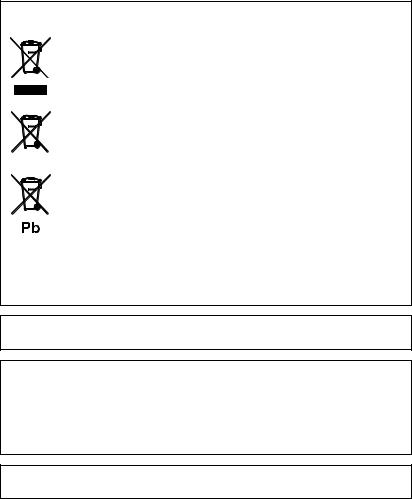
■ Remarques à propos des télécommandes et piles
•Ne renversez aucun liquide sur le boîtier de télécommande.
•Ne laissez pas tomber le boîtier de télécommande.
•Ne laissez pas et ne rangez pas le boîtier de télécommande dans les endroits suivants:
–très humides, par exemple près d’un bain
–très chauds, par exemple près d’un poêle ou d’un appareil de chauffage
–exposés à des températures très basses
–poussiéreux
•Installez la pile en respectant les repères de polarité (+ et –).
•Changez toutes les piles lorsque les symptômes suivants se présentent:
–la portée du boîtier de télécommande diminue
–le témoin de transmission ne clignote pas ou l’intensité est faible
•Si la pile est plate, retirez-la immédiatement de la télécommande pour éviter tout risque d’explosion ou de fuite d’acide.
•Si vous remarquez une fuite au niveau des piles, mettez-les immédiatement au rebut en prenant soin de ne pas toucher le produit qui a fui. Si le produit qui a fui entre en contact avec votre peau ou vos yeux ou votre bouche, rincez immédiatement et consultez un médecin. Nettoyez soigneusement le logement des piles avant de mettre en place des piles neuves.
•N’utilisez pas à la fois des piles neuves et des piles usagées. Cela risque de réduire la durée de vie des nouvelles piles ou d’entraîner une fuite des piles usagées.
•N’utilisez pas non plus des piles de deux types différents (par exemple, des piles alcalines et des piles au manganèse). Les caractéristiques des piles peuvent être différentes même si elles semblent identiques.
•Avant de mettre la nouvelle pile en place, essuyez soigneusement le compartiment.
•Si les piles sont retirées pendant plus de 2 minutes, ou si elles sont complètement usagées, le contenu de la mémoire est effacé. Dans ce cas, installez des piles neuves et réglez le code de commande.
•Mettez la pile au rebut conformément aux lois en vigueur dans votre région.
•Conservez les piles hors de portée des enfants. SI une pile est avalée accidentellement, contactez immédiatement votre médecin.
•Si vous prévoyez de ne pas utiliser la télécommande pendant une période prolongée, retirez les piles de la télécommande.
•N’essayez pas de charger ou de démonter les piles fournies.
•Les piles ne doivent pas être exposées à une chaleur extrême, par exemple au soleil, à une flamme, etc.
Information concernant la collecte et le traitement des piles usagées et des déchets
d’équipements électriques et électroniques
Les symboles sur les produits, l’emballage et/ou les documents joints signifient que les
produits électriques ou électroniques usagés ainsi que les piles ne doivent pas être mélangés
avec les déchets domestiques habituels.
Pour un traitement, une récupération et un recyclage appropriés des déchets d’équipements électriques et électroniques et des piles usagées, veuillez les déposer aux points de collecte prévus à cet effet, conformément à la réglementation nationale et aux Directives 2002/96/EC et 2006/66/EC.
En vous débarrassant correctement des déchets d’équipements électriques et électroniques et des piles usagées, vous contribuerez à la sauvegarde de précieuses ressources et à la prévention de potentiels effets négatifs sur la santé humaine qui pourraient advenir lors d’un traitement inapproprié des déchets.
Pour plus d’informations à propos de la collecte et du recyclage des déchets d’équipements électriques et électroniques et des piles usagées, veuillez contacter votre municipalité, votre service de traitement des déchets ou le point de vente où vous avez acheté les produits.
[Information sur le traitement dans d’autres pays en dehors de l’Union
Européenne]
Ces symboles sont seulement valables dans l’Union Européenne. Si vous souhaitez vous débarrasser de déchets d’équipements électriques et électroniques ou de piles usagées, veuillez contacter les autorités locales ou votre fournisseur et demander la méthode de traitement appropriée.
Note pour le symbole « pile » (les deux symboles du bas) :
Ce symbole peut être utilisé en combinaison avec un symbole chimique. Dans ce cas il respecte les exigences établies par la Directive pour le produit chimique en question.
Pour de plus amples informations, reportez-vous au Mode d’emploi qui se trouve sur le CD-ROM. Attention : N’essayez pas de lire ce CD-ROM dans un lecteur audio.
Pour afficher le Mode d’emploi, cliquez sur « Français » sur l’écran qui s’affiche automatiquement lorsque vous insérez le CD-ROM dans votre PC ou cliquez sur le nom du modèle si l’écran pour sélectionner les modèles s’affiche, ensuite, cliquez sur « Français » sur l’écran suivant. Ensuite, suivez les instructions à l’écran.
Si l’écran ne s’affiche pas automatiquement, ouvrez le fichier « index.html » sur le CD-ROM. Vous pouvez télécharger le Mode d’emploi inclus sur le CD-ROM sur le site Web suivant: URL : http://download.yamaha.com/
Ne pas utiliser cet appareil à moins de 22 cm de personnes ayant un stimulateur cardiaque ou un défibrillateur.
18 Fr
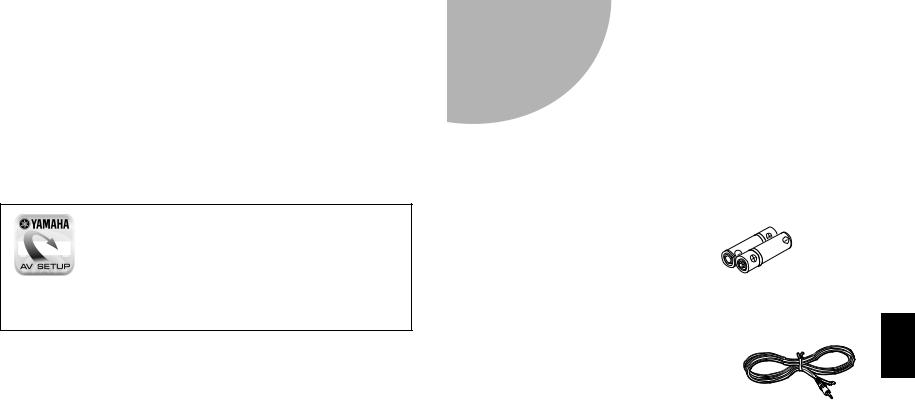
Ce document décrit la configuration de base du système d’enceinte et la configuration de l’unité, suivies d’instructions étape par étape. Les opérations de base, comme la lecture de disques Blu-Ray, de DVD et de contenu radio, sont également expliquées.
L’unité est pourvue d’autres fonctions non décrites dans ce livret. Pour de plus amples informations sur ce produit, reportez-vous au Mode d’emploi inclus sur le CD-ROM fourni. Vous pouvez télécharger le Mode d’emploi le plus récent depuis le site Web suivant. http://download.yamaha.com/
AV SETUP GUIDE
AV SETUP GUIDE est une app qui vous guide à travers le processus de connexion d’un téléviseur ou d’un appareil de lecture, comme un lecteur BD/ DVD ou CD, et des enceintes à l’ampli-tuner audiovidéo. Recherchez « AV SETUP GUIDE » sur l’App Store ou Google Play pour en savoir plus.
1Préparatifs
Vérification du contenu de l’emballage
Piles (AAA, R03, UM-4) (x2)
Télécommande
Antenne AM |
Antenne FM |
Microphone YPAO |
L’élément fourni dépend de la région d’achat.
CD-ROM (Mode d’emploi)
Guide de démarrage rapide (ce livret)
Préparation des câbles
Les câbles suivants (non fournis) sont nécessaires pour réaliser le système décrit dans ce document.
•Câbles d’enceinte (en fonction du nombre d’enceintes)
•Câble de broche audio (x1)
•Câbles HDMI (x3)
Fr 19

2Raccordement des enceintes ou du caisson de graves
Positionnement des enceintes
Positionnez les enceintes en vous servant du schéma comme référence.
1
 2
2
9 3
3
4 5
10° à 30° |
|
|
|
|
|
10° à 30° |
|
|
|
|
|
1Enceinte avant (G)
2Enceinte avant (D)
3Enceinte centrale
4Enceinte d’ambiance (G)
5Enceinte d’ambiance (D)
9Caisson de graves
Lors du raccordement d’enceintes 6 ohms
(modèles pour les États-Unis et le Canada uniquement)
Réglez l’impédance des enceintes de l’unité sur « 6 Ω MIN ». Pour en savoir plus, voir « Réglage de l’impédance des enceintes » dans le Mode d’emploi.
Précautions relatives au raccordement des câbles d’enceinte
•Assurez-vous que l’unité et le caisson de graves sont hors tension.
•Préparez les câbles d’enceinte loin de l’unité pour éviter de lâcher par inadvertance les torons de câble à l’intérieur de l’unité ce qui pourrait provoquer un court-circuit ou un dysfonctionnement de l’unité.
•Un branchement incorrect des câbles d’enceinte pourrait provoquer un court-circuit, entraînant des dommages ou un dysfonctionnement de l’unité ou des enceintes.
– Retirez délicatement environ 10 mm d’isolant des extrémités des câbles pour la connexion aux enceintes, et torsadez ensemble les fils dénudés de chaque câble d’enceinte solidement.
– Ne laissez pas les fils dénudés de câbles d’enceinte séparés entrer en contact les uns avec les autres.
– Ne laissez pas les fils dénudés des câbles d’enceinte entrer en contact avec les pièces métalliques sur l’unité (face arrière et vis).
Si « Check SP Wires » apparaît sur l’afficheur de la face avant à la mise sous tension de l’unité, éteignez-la, puis assurez-vous que les câbles d’enceinte n’ont pas provoqué un court-circuit.
20 Fr
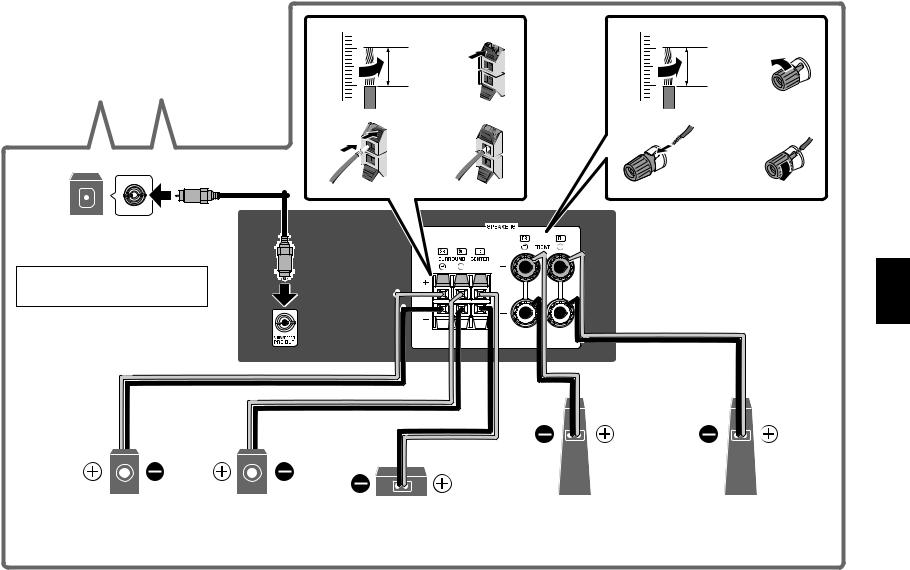
1 |
2 |
|
10 mm |
3 4
Câble de broche audio
9
Caisson de graves
Utilisez un caisson de graves équipé d’un amplificateur intégré.
5 |
4 |
3 |
1 |
2 |
|
10 mm |
3 4
2 1
Enceinte d’ambiance (D) Enceinte d’ambiance (G) |
Enceinte centrale |
Enceinte avant (D) |
Enceinte avant (G) |
Fr 21
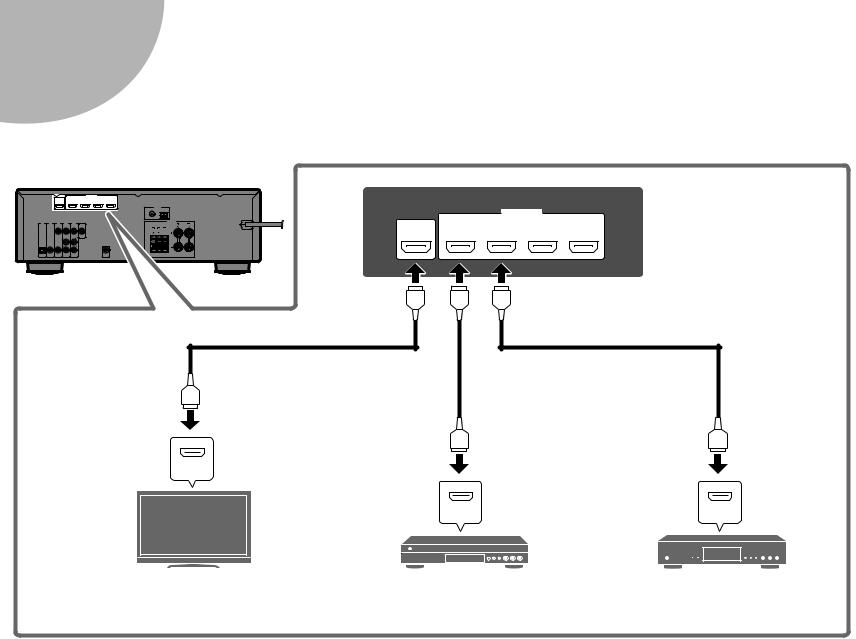
3Raccordement des appareils externes
HDMI OUT
ARC
HDCP2.2
|
|
HDMI (HDCP2.2) |
|
1 |
2 |
3 |
4 |
(BD/DVD) |
|
|
|
HDMI |
HDMI |
HDMI |
HDMI |
|
HDMI |
HDMI |
Entrée HDMI |
|
HDMI |
|
Sortie HDMI |
Sortie HDMI |
HDMI |
HDMI |
|
|
|
|
Téléviseur |
Lecteur de disques BD/DVD |
Décodeur satellite/câble |
|
22 Fr

4Raccordement des antennes FM/AM
Antenne FM (fournie) |
|
Assemblage de l’antenne AM |
|
Fixez l’extrémité de |
|
Placez l’antenne |
|
l’antenne FM à un |
|
||
|
AM sur une |
||
mur. |
|
||
Antenne AM (fournie) |
surface plane. |
||
|
|||
|
|
Abaissez |
Insérez |
Relâchez |
Fr 23
